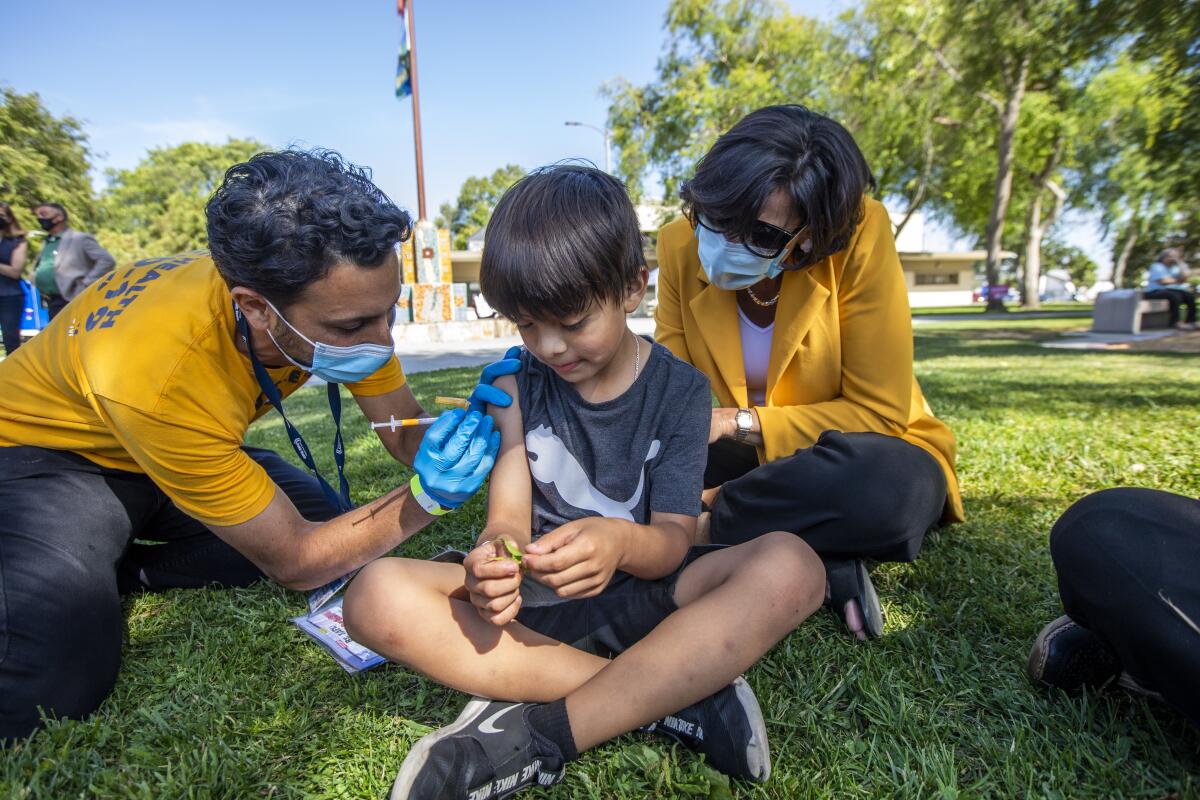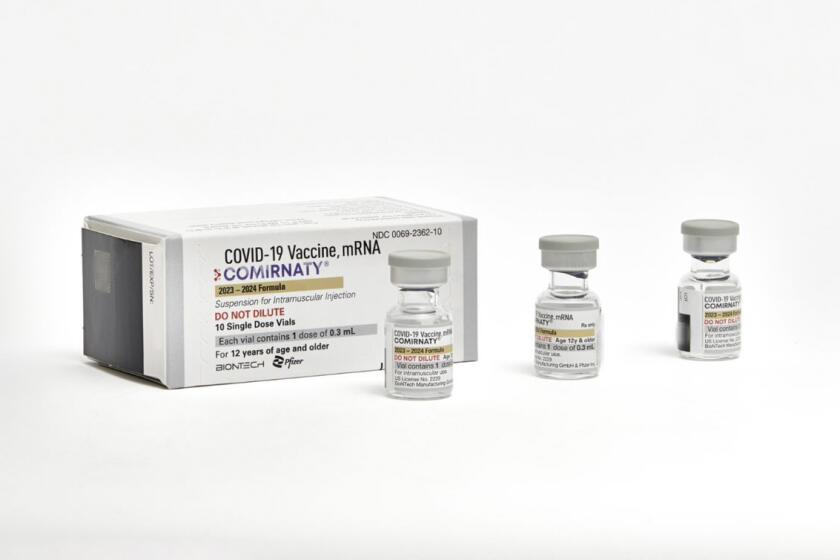New COVID-19 vaccinations are coming, CDC says. The shots will likely be available this week

- Share via
The U.S. Centers for Disease Control and Prevention on Tuesday recommended that much of the American public receive an updated COVID-19 vaccine, marking a new phase in the years-long battle against the coronavirus.
Should everything move forward as expected, the shots from Moderna and Pfizer-BioNTech could be available for everyone age 6 months and up in vaccine clinics, pharmacies and doctor’s offices later this week. CVS Health said the new shots will be available in some of its pharmacies as early as Wednesday.
One key question remains, however: How many people will roll up their sleeves?
COVID vaccinations now appear to be mirroring the seasonal cadence of the flu shot — with freshly formulated versions released annually in hopes of combating the dominant viral strain circulating in a given year.
It’s a goal public health officials have long held, and reflects the shift out of the emergency phase of the pandemic into an era where the coronavirus, though still prevalent, merits more of a predictable schedule than a rapidly shifting response.
But as of this spring, just 21% of adults, and 43% of seniors, nationwide had received the updated COVID-19 vaccine that first became available a year ago. That lags estimated uptake of the flu shot. Preliminary surveys estimate that as of early spring, half of all adults and more than 70% of seniors had received a flu shot.
In order to move through a world where the coronavirus is endemic, we need a reliable way to assess our individual level of immunity. Here’s how we can.
Still, as the idea of annual COVID-19 vaccinations becomes more routine, it’s possible more people may decide to get them. A survey taken in August and presented by the CDC on Tuesday found that about 43% of adults plan to either probably or definitely get this autumn’s COVID-19 vaccine, while 18% were unsure and 39% said they probably or definitely would not.
While COVID-19 has become less deadly thanks to vaccines, therapeutic drugs such as Paxlovid, years of built-up natural immunity and a more slowly evolving coronavirus, it can still cause plenty of disruption, and be deadly for some people.
“COVID-19 burden is currently lower than at previous points in the pandemic. However, the absolute number of hospitalizations and deaths is still high,” Megan Wallace, a CDC epidemiologist, said during Tuesday’s advisory committee meeting. “Although hospitalization rates are currently low in some age groups, we have seen rates increase in recent weeks, and anticipate further increases as we enter respiratory virus season.”
CDC Director Dr. Mandy Cohen on Tuesday gave her official recommendation that generally everyone age 6 months and up get an updated COVID-19 vaccination — echoing the determination made just hours earlier by the agency’s Advisory Committee on Immunization Practices.
“Vaccination remains the best protection against COVID-19-related hospitalization and death,” the CDC said in a statement. “Vaccination also reduces your chance of suffering the effects of long COVID, which can develop during or following acute infection and last for an extended duration.”
Members of the panel were largely enthusiastic about the universal vaccine recommendation.
“Let’s keep America strong, healthy. Let’s do away with COVID-19 as best we can by prevention of disease through vaccines,” said panel member Dr. Camille Kotton, an infectious-disease clinician at Massachusetts General Hospital and associate professor at Harvard Medical School.
With the emergency phase of COVID-19 over, a Los Angeles Times analysis shows how the pandemic took different tolls on L.A. County and New York City.
The latest vaccine was formulated to target an Omicron subvariant that was dominant earlier this year: XBB.1.5, unofficially known as Kraken. Though it’s a monovalent shot, meaning it was specifically designed to target that strain, recent data suggest the updated vaccine will continue to provide strong protection against closely related, more recently emerging subvariants such as EG.5, also known as Eris; and BA.2.86, unofficially dubbed Pirola.
Available information “suggests that the vaccines are a good match for protecting against the currently circulating COVID-19 variants,” according to the U.S. Food and Drug Administration.
The new formula replaces last year’s version of the vaccine, which was a bivalent shot targeting not only the BA.5 subvariant that was dominant for a good portion of 2022, but also the ancestral coronavirus strain that swept across the globe in early 2020. People who got last autumn’s COVID-19 vaccination “saw greater protection against illness and hospitalizations than those who did not,” the CDC said.
Officials have said the new shot no longer needs to be designed against the ancestral coronavirus strain, which is essentially extinct. Virtually all coronavirus cases today are caused by descendants of Omicron, a highly infectious variant that initially emerged in late 2021.
U.S. regulators have approved updated COVID-19 vaccines from Pfizer and Moderna, which are aimed at revving up protection this fall and winter.
Specifically, federal health officials made the following recommendations:
• Adults and children age 5 and older can receive a single dose of this autumn’s updated COVID-19 vaccine from either Moderna or Pfizer-BioNTech, as long as it has been two months since their last dose.
• Previously vaccinated babies and young children, ages 6 months to 4 years, can receive one or two doses of the updated Moderna or Pfizer-BioNTech vaccine. The timing and number of doses will depend on which COVID-19 vaccine they previously received.
• Unvaccinated babies and young children in this age group can receive two doses of the updated Moderna vaccine or three doses of the updated offering from Pfizer-BioNTech.
The law was intended to protect patients from physicians who gave advice they knew to be false or misleading. But many doctors feared it was too vague.
CDC officials say that people who recently have had COVID-19 can either get the new vaccination as soon as they feel better or wait three months — the timing is up to the patient.
Tuesday’s action does not affect Novavax.
In a statement Monday, the FDA said it “is confident in the safety and effectiveness of these updated vaccines.”
“The updated vaccines are expected to provide good protection against COVID-19 from the currently circulating variants. Barring the emergence of a markedly more virulent variant, the FDA anticipates that the composition of COVID-19 vaccines may need to be updated annually, as is done for the seasonal influenza vaccine,” the agency said.
Los Angeles County officials said they have no plans for new public mask mandates — a sign of how COVID-19 policies have changed in the back-to-normal era.
From last October through April, more than 70,000 COVID-19 deaths were reported nationally.
That’s far fewer than the comparable time period the prior year, when more than 270,000 died. The first autumn-winter wave of the pandemic was the worst, with more than 370,000 people dying between October 2020 through the end of April 2021, when vaccinations were either not yet released or were still generally in short supply.
COVID-19 is still causing more deaths than the flu, but it’s far less of a public health threat than it used to be.
Between October and the end of April, COVID-19 caused about double the number of deaths that the flu has caused annually, on average.
Flu generally causes 35,000 deaths a year, based on an average of the 10 flu seasons preceding the pandemic. Between last October and the end of April, flu was estimated to cause somewhere between 19,000 and 58,000 deaths.
Here’s what you need to know about flu shots and when to get them, based on the latest information from the U.S. Centers for Disease Control and Prevention.
Staying current on COVID-19 vaccines continues to lower the risk of adverse health outcomes and death, especially for older people, experts say. Most people who were hospitalized with COVID-19 since January were not current on their vaccination, according to the CDC.
It’s also still possible for normally healthy children and younger adults to become seriously ill with COVID-19.
Among adults under the age of 50 who were admitted to an intensive care unit with COVID-19 between July 2022 and last June, 13% had no underlying conditions. The same was true of 22% of adolescent ICU COVID patients. Among babies and young children age 6 months to 23 months, more than half admitted to the ICU with COVID-19 had no underlying health conditions.
And while incidence of long COVID has decreased since the start of the pandemic, symptoms associated with the condition are still common following coronavirus infection, Wallace said.
More to Read
Sign up for Essential California
The most important California stories and recommendations in your inbox every morning.
You may occasionally receive promotional content from the Los Angeles Times.




















